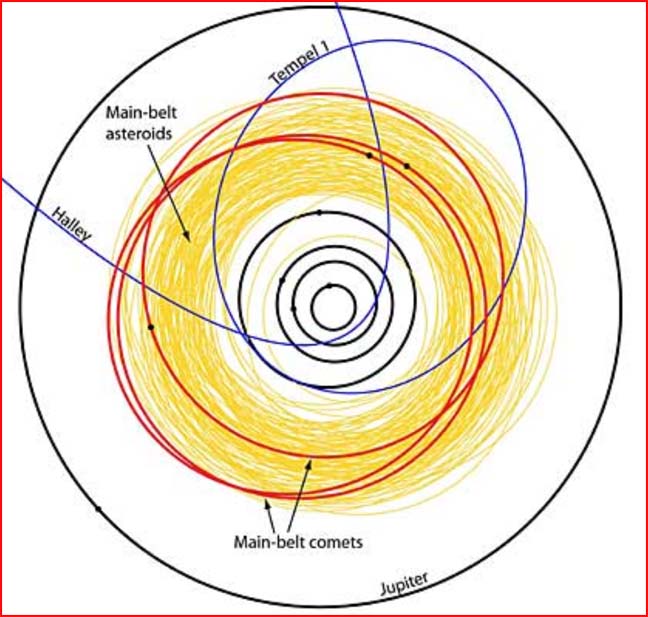
Posted on 04/11/2006 3:06:42 PM PDT by blam
Hybrid comet-asteroid in mysterious break-up
09:30 11 April 2006
NewScientist.com news service
Jeff Hecht

The large, diffuse breakaway object is centred at the 2 o'clock position relative to the nucleus. The image is a negative, with the darkest areas representing the brightest objects.
Something substantial has broken off an icy 50-kilometre object beyond the orbit of Saturn, leaving puzzled astronomers trying to figure out why.
Comets have been seen breaking up before, but only after heating when passing close to the Sun or a gravitational disturbance following a close encounter with a planet.
However, at 1.9 billion kilometres, this object is very far from the Sun. Another mysterious feature is that much more gas and dust is escaping from the breakaway fragment than from the parent body. The disintegration has created a dust cloud more than 100,000 km across and which is several times brighter than the original object was before the event.
The object, called 60558 Echeclus, was discovered in 2000 and is a “centaur” - part rocky asteroid and part icy comet. Its new activity, revealed in images taken on 2 April, makes it look “really strange", says William Romanishen of the University of Oklahoma, US, one of the team that took the images. "The first thing that came to mind was a collision."
Earlier observations showed Echeclus rotates about once every 26 hours, so a fragment would need a push to escape its gravity, says Paul Weissman of the Jet Propulsion Laboratory, who spotted the original cloud of gas and dust around Echeclus on 30 December 2005.
Explosive sublimation
Such an impact on a comet-like body has not been observed before. But there are other possibilities, says Steve Tegler of Northern Arizona University, US, who works with Romanishen. He says it is most likely that the event was caused by explosive sublimation of volatile ices in Echeclus, resulting in material being blasted off.
Tegler says the evaporating ice is probably carbon monoxide, with vaporises at about that distance from the Sun, where the object's temperature is about 80 degrees Kelvin, close to the sublimation temperature. No one has yet analysed the gas composition.
Another puzzle is the difference in activity between the main nucleus and the fragment. Freshly exposed ices normally sublimate, so "you'd expect equal activity from both pieces", Wiessman says. But the nucleus does not look very active.
Unstable orbits
Echeclus was discovered by the Spacewatch telescope in 2000, and at first looked like an asteroid. Then Weissman found it was surrounded by a coma, so astronomers also classed it as a periodic comet, 174P. The photos from 2 April show the coma has now spread out.
Echeclus belongs to a group of more than 100 centaurs with orbits well outside the main asteroid belt. Although originally from the distant Kuiper belt, they now orbit the Sun between Jupiter and Neptune, but will be ejected from those unstable orbits within tens of millions of years. Cometary clouds have been reported around three other centaurs too.
Echeclus is currently moving towards the Sun on its 35-year orbit, and will pass closest to our star - about 880 million km - in April 2015. Other centaurs have become active as they moved inward, Tegler says. But none have shown such dramatic activity.
I blame the breakup on Yoko.
Alien mining?
Well, it's usually Yoko, but I think this time it was "musical differences".
Escape Pod leaving mother ship.
Global warming now affecting other planets. SUV drivers are destroying our solar system.
Yup! It;s the Mothership pulling away from the comet. It saved fuel by hitchin' itself to the comet for a free ride. Musta known about Earth's gas prices!
Would it be a suprise to find somebody [a non-signatory to the 1967 UN Outer Space Treaty] mining in the Solar System? Some people expect that. Most haven't thought about it.
...... and I thought 'Breaking Up is Hard To Do'.
They may be using it as a back-stop for target practice.
LOL!
It's the Ori!!!

LOL
Deep Impact—Where’s the Water? (1)
Deep Impact—Where's the Water? (2)
Deep Impact—Where's the Water? (3)
Nor is it the first time a comet has been observed breaking up or flaring a coma at an extraordinary distance.
Deep Impact">and Shoemaker-Levy 9
Below is a link to an article on the difference between asteroids and comets according to the Electric Universe Cosmologists:

Orbits of the three known main-belt comets (red lines), the five innermost
planets (black lines; from the center outward: Mercury, Venus, Earth, Mars,
and Jupiter), a sample of 100 main-belt asteroids (orange lines), and two
"typical" comets (Halley's Comet, and Tempel 1, target of the recent Deep
Impact mission) as blue lines. Positions of the main-belt comets and planets on
March 1, 2006, are plotted with black dots. Image credit: Pedro Lacerda
(Univ. Hawaii; Univ. Coimbra, Portugal)
Disclaimer: Opinions posted on Free Republic are those of the individual posters and do not necessarily represent the opinion of Free Republic or its management. All materials posted herein are protected by copyright law and the exemption for fair use of copyrighted works.